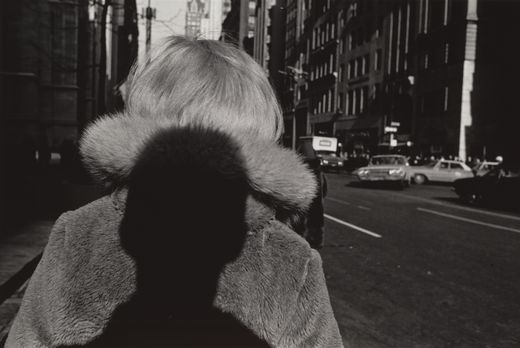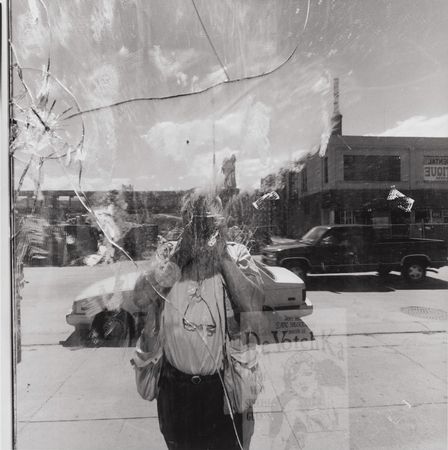Lee Friedlander, or on identity and self.
Late late last night I was looking through MOMA’s collection of photography. My initial interest was looking at work by unknown photographers, unattributed work, since through the day I’d had this line of thought in regards to identity, reflection of self, authorship, etc, that I was unable to order or find completion in, and viewing work w/o authors seemed like it may prompt uniformity in the line of thought, if you could call it a line. Though a reasonable hope, it ended up being false hope. But I kept clicking through the collection.
And as I ran later and later into the collection I noticed a photographer’s name over and over, Lee Friedlander. I know the name Friedlander, know he’s still alive, know he shoots documentry work of sorts, but even knowing these things I’d never actually looked at or thought about his work. So I did. And I came away thinking that he uses the camera in an entirely imaginative and creative manner that isn’t, how should I say, contrived, or maybe that there appears to be a lack of self-consciousness in his images is a more appropriate phrasing. Instead, his pictures, especially his later works, seem wholly visceral (and b/c of this somehow unmitigated, as you can understand). And to me work that is visceral is most often brave, and brave work is what any artist should strive for.
First, his series of TVs on in empty rooms. I love these. I wish I’d taken these. But I’m acutely aware that any picture of a TV in an empty room will always be in the footsteps of Friedlander.

photo: Galex, Virginia. 1962. © Lee Friedlander, 2007.
Then there are his pictures that his own shadow plays an integral part in. I love these. I wish I’d taken these. But I’m acutely aware that any picture that the photographer’s shadow plays an integral part in will always be in the footsteps of Friedlander.

photo: New York City. 1966. © Lee Friedlander, 2007.
Then, similarly, there are his images with his reflection. I love these. I wish I’d taken these. But I’m acutely aware that any picture with the photographer’s reflection in a window will always be in the footsteps of Friedlander.

photo: Denver, Colorado. 1998. © Lee Friedlander, 2007.
Then, finally, there are his self portraits. Often behind sparse foliage. Initially I did not love these and did not wish I’d done them. But after going through his body of work and seeing how he’d arrived here. I did love them and did wish I’d done them. But I’m acutely aware that any self portrait of photographer behind sparse foliage will always be in the footsteps of Friedlander.

photo: California. 1997. © Lee Friedlander, 2007.
Now I wish to return to the initial topic of this post, and that was my researching unattributed works to better understand and to explore ideas of identity, image, self awareness, reflection, etc. Initially, I asked, what are we but a series of ideas and events that we’ve compiled? Then I thought of self-projection, and thus authorship and began to ask if something in the specific realm of the artist could elucidate a more universal premise. You get the idea. I too quickly concluded the MOMA collection wasn’t going to be much inspiration.
Then Friedlander distracted me.
Then I went to bed.
Then at some point late last night staring at the too yellow street light out my window, I realized Friedlander’s work was what I’d been looking for the entire time. Once I got past wishing I’d taken his pictures, I saw the obvious: that identity, reflection, self-awarenesses, and so forth, are all central issues he’s confronting. What I’ve yet to get my head around is whether he is simplifying or complicating these issues. Is he projecting self, or raising questions around self? Is his work a testimony, a stamp, a marking, a graffiti on the wall exclaiming, Lee was here? Or is it an obscuring of self, a questioning of what makes self up, the photographer/author apparent in his work, meta, post-mod, self as a shadow on others, as a cracked reflection in a store window, as a grotesque figure within yet obviously different from nature?
I don’t know, but it seems like something worth thinking about.
Lots of photographers other than Friedlander have taken pictures with themeselves in a reflection. The one that stands out to me is Atget, who might not have intended it to be so important, but historically that’s what it has become because there are so few pictures of him, so people who are interested in him are forced to look closely at the few pictures that he took where he is visible in a reflection. And he did it consciously to construct a mystery, I think.
I agree with your statement, Max, but would debate what you’re implying, b/c, yes, while lots of other photographers have dabbled in such things as their reflections, Friedlander remains the guy who made it his own. Just like how many people have shot ‘scapes from their car window, and cont to do so, but it’s still intrinsically Friedlanderish.
Thanks for pointing out the Atget reference. I’m going to research that.